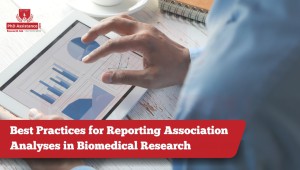Reporting Association Analysis
Best Practices for Reporting Association Analyses in Biomedical Research
Principles and Best Practices
- Introduction
- Clearly Describe the Association of Interest
- Identify and Summarize Variables
- Specify the Statistical Test of Association
- Report Statistical Significance Transparently
- Report Measures of Association with Confidence Intervals
- Present Supporting Data
- Identify the Statistical Software Used

Recent Post
Introduction
Association analyses are core methodologies in biomedical and public health research, and they are commonly used to evaluate relationships between variables such as exposure/outcome, biomarker/disease, or policy contexts/behaviours. However, the potential to produce meaningful findings through the association analysis of variables is intimately tied to the transparency and rigor by which these association analyses are reported. Reporting practices can undermine reproducibility, credibility, and interpretability if it includes imprecise descriptions, offered without the necessary statistical details, or unqualifies commonly misused terms like “significant” or “strong.”
The article discusses best practice reporting methods for association analyses and connects to other methodological guidance and peer-reviewed examples from recent literature. Using structured principles, the confidence and scientific transparency of reports of association analyses is increased.
Clearly Describe the Association of Interest
Present Supporting Data
Identify the Statistical Software Used
Conclusion
The accurate and complete reporting of association analyses improves the transparency, reproducibility, and consequential-ness of scientific research. There is much work put into scientific research and as each section of the reporting follows an explicit thought process from defining variables and hypotheses to testing them and reporting effect sizes with confidence intervals, adds to the logical and scientific reporting.
As the field moves toward open science and data sharing, these best practices, supported by recent methodological and applied research, will help assure research findings can be both trusted and valuable to the broader scientific community.
Require Professional Help Alongside Reporting Association Analyses for Your Biomedical Work?
PhD Assistance Research Lab has dedicated services to help you report your association analyses accurately and transparently in your study.
Contact us today to ensure that your study complies with the best statistical reporting practices to enhance the credibility and reproducibility of your research to successfully publish your work!
References
1. Abdul Rahman, H., Noraidi, N., Hj Khalid, K., et al. (2025). Practical guide to calculate sample size for chi-square test in biomedical research. BMC Medical Research Methodology, 25, 144. https://doi.org/10.1186/s12874-025-02584-4
2. Bahadoran, Z., Mirmiran, P., Kashfi, K., & Ghasemi, A. (2025). Biomedical research: Formulating a well-built and worth-answering research question. Addiction & Health, 17, 1564. https://doi.org/10.34172/ahj.1564
3. Dwivedi, A. K., Ahmed, S., & Dubey, P. (2025). EXPRESS: Evidence-based biostatistics and value-based biostatistics practices in biomedical research: Application to evaluating the association between phthalate metabolites and sex hormones in US male adults. Journal of Investigative Medicine. Advance online publication. https://doi.org/10.1177/10815589251350922
4. Goodman, M. O., Faquih, T., Paz, V., et al. (2025). Genome-wide association analysis of composite sleep health scores in 413,904 individuals. Communications Biology, 8, 115. https://doi.org/10.1038/s42003-025-07514-0
5. Gouveia, M. H., et al. (2025). [Title not provided]. The American Journal of Human Genetics, 112(6), 1286–1301.
6. Larsen, P. P., Féart, C., Pais de Barros, J. P., Gayraud, L., Delyfer, M.-N., Korobelnik, J. F., Schweitzer, C., & Delcourt, C. (2024). Association of lipopolysaccharide-type endotoxins with retinal neurodegeneration: The Alienor Study. Ophthalmology Science, 5(1), 100610. https://doi.org/10.1016/j.xops.2024.100610
7. Patterson, R., Ogilvie, D., Hoenink, J. C., Burgoine, T., Sharp, S. J., Hajna, S., & Panter, J. (2025). Combined associations of takeaway food availability and walkability with adiposity: Cross-sectional and longitudinal analyses. Health & Place, 91, 103405. https://doi.org/10.1016/j.healthplace.2024.103405
8. Pessar, S. C., Smart, R., Naimi, T., Lira, M., Blanchette, J., Boustead, A., & Pacula, R. L. (2025). The association between state cannabis policies and cannabis use among adults and youth, United States, 2002–2019. Addiction, 120(1), 164–170. https://doi.org/10.1111/add.16663

